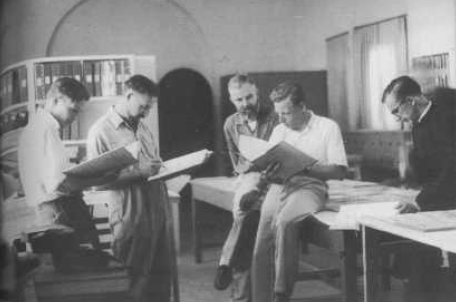John M. Allegro (1923-1988), with a random Arab in the background.
So these Dead Sea Scrolls were quite the find 60 years back, and it was not before long that an international team of 8 scholars was formed in 1953 to decipher and translate the ancient texts. Part of this group was the then 30-year old John Marco Allegro from Manchester University, a philologist and self-proclaimed agnostic (meaning that he believed that the truth value of any statement about the divine or supernatural was ultimately unknowable). Good for the team, you might think. The only problem was that all the other researchers were ordained Catholic priests, and trouble was thus not far coming, especially because Allegro was somewhat of a publicity hound and preferred to speak to the popular press instead of to the "sanctioned" professional journalists that probably swallowed the conservative viewpoints of Allegro's Catholic co-workers with as much enthusiam as they did their sacramental bread.
Allegro and the team immediately clashed on what he perceived as their reservation and unwillingness to make too much details on the content of the Scrolls publicly known and the snail's pace they worked at.* They for their part found Allegro's outgoing style and unorthodox theories hard to bear. Things came to a head in 1957 when Allegro independently opened the so-called "Copper Scroll" and started working on it by himself. Allegro was convinced that the document referred to a treasury where "the sect's most precious possessions could be found". Program director Roland de Vaux of the Domican Order thought otherwise, and dismissed Allegro's speculating as fiction and his subsequent hunt for the supposed treasure as a worthless effort. Meanwhile, Allegro had come to view the Essenes as forerunners of Christianity and claimed that they had also worshipped a crucified savior, which of course exasperated the god-fearing de Vaux and his priestly colleagues.
Some members of the international team, with Allegro second left.
In 1960 the rift was becoming openly visible as Allegro clandestinely published The Treasure of the Copper Scroll, which de Vaux denounced as dishonest and imprecise. Allegro however, had found his stride as an independent, anti-establishment rhetorician and attacked de Vaux and the rest of the team in the August edition of Harper's Magazine, where he accused them of deliberately withholding content of the Scrolls because of their supposed incongruity with the Christian doctrine. In 1979 The Dead Sea Scrolls and the Christian Myth appeared, discussing the theory that the story of Jesus in the four gospels were narrative fictions based on the motif of the Teacher of Righteousness as found in some of the Scrolls.
But Allegro was not the only one to rage against the secretiveness of the Dead Sea Scrolls-team. Two years earlier noted Bible-scholar Geza Vermes had spoken of a looming "academic scandal" if the tempo of publication of the Scrolls was not increased. Yet here we are almost 35 years later and no one seems to care one inch of a dead donkey's balls anymore. But now you do! Once again I have brought you enlightenment and sensational knowledge, and exposed the inadequacies of common learning for all the world to see!
But what happened to John Allegro? Well, he would go on to publish one particular book that forever changed his standing within academia......
Cliffhanger! Come back next time!
*Quite justified as it later turned out, because it was not until 1992 that a complete translation of the Scrolls would appear (The Dead Sea Scrolls Uncovered by Robert Eisenman and Michael Wise).


Thank you for this. I would like to comment on the picture. The man in the background is far from random. With his appearance in many unrelated pictures from all over the world there is more to it. It must be Koko Bibutsi. Look it up. I believe you might have mentioned it in one of your outstanding papers.
ReplyDelete